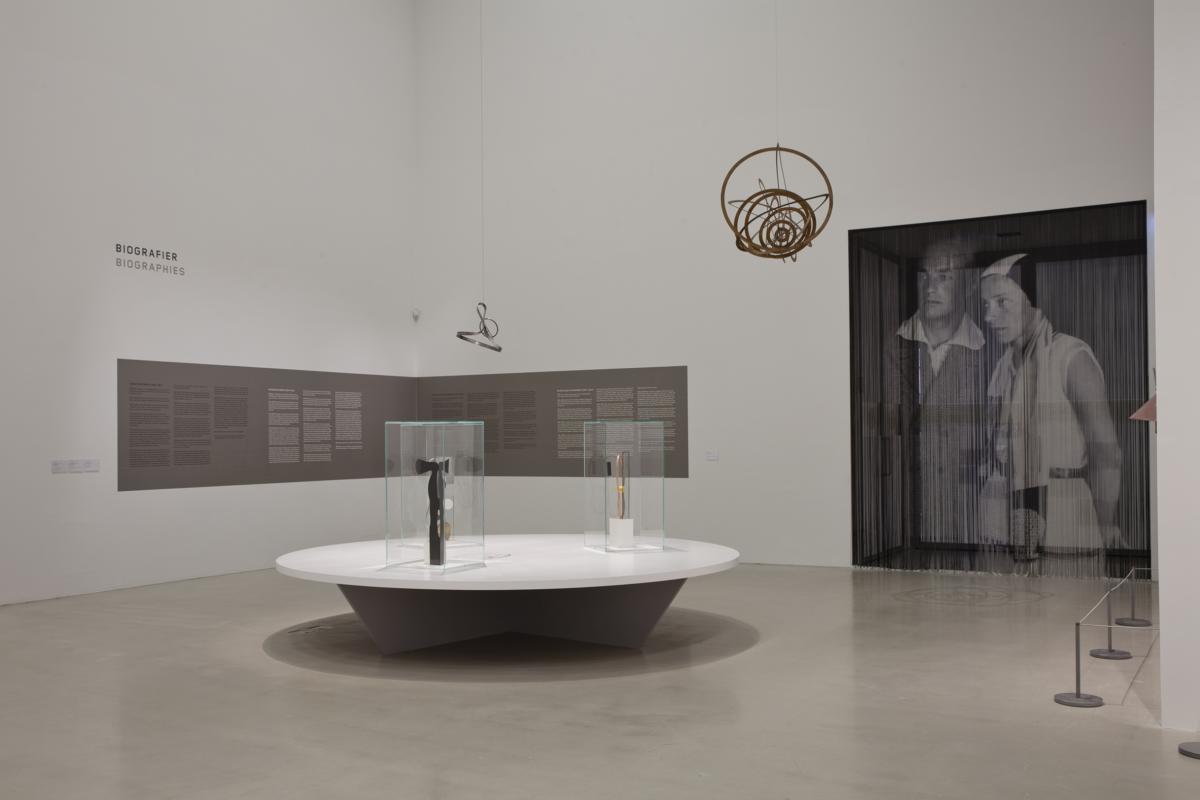
The work of Katarzyna Kobro and Władysław Strzemiński is seen as a manifestation of the modernistic quest for the essence of art, a search that led the Polish artists to elaborate their own theoretical system: unism. The aim of unism was to create work that is “organic unity” by its organicity parallel with nature and, according to Kobro and Strzemiński, such unity can be achieved only by the accordance of means used in the production of the work with objective laws that define its nature.[1] This meant that, for example, painting should be based on properties specific to painting itself, and sculpture on the properties specific to sculpture itself – and that they should be purified of any alien elements.
Seemingly, then, Kobro and Strzemiński dedicated themselves to purely formal experimentation: the investigation and analysis of intrinsic aspects of artistic creation. It is also said that by means of organically organized work they sought to articulate a universal order of nature. The political dimension of their art is less evident, but, as a matter of fact, all these efforts to formulate a perfect unity are immersed in a specific form of politics. This form can be called a biopolitics.
According to Michael Foucault, biopolitics is a specific modern form of governance, which began to develop more or less in the eighteenth century and takes the administration of individual life and populations as its subject. It tends – as Foucault writes – “to ensure, sustain, and multiply life, to put this life in order.” While the earlier politics was an expression of the sovereign’s will formulated in juridical terms and was focused on legal subjects, biopolitics refers to living beings and denotes the tendency to take into account the natural life of humans – their bodies, emotions, and desires – in the calculations and mechanisms of political powers. As Foucault points out in his famous The History of Sexuality: “For millennia, man remained what he was for Aristotle: a living animal with the additional capacity for a political existence; modern man is an animal whose politics places his existence as a living being in question.”[2]
The art of Kobro and Strzemiński referred to such biopolitics in at least three ways. Firstly, by providing prototypes intended to help with invention of ideal forms of social organisation. Secondly, by designing functional solutions to regulate the life of the individual and of society as a whole. And thirdly, by producing aesthetic devices that stimulate and organize pro-social attitudes and emotions of individuals. The two latter correspond with the two axes of Foucault’s biopolitics: administration of the population and disciplining the individual body. The first recalls a particular manifestation of biopolitics that was popular in the 1920s and 1930s and was associated with the previously mentioned concept of organicity.
Organicity appeared in Strzemiński’s writings from the very beginning along with the metaphor of the art work as a living being. According to the artist, any kind of art, like any organism, is constituted by its own intrinsic laws. Therefore the role of an artist is to identify these laws and execute an artwork in accordance with them. An artist should not repeat previously existing forms of nature but create an artwork in the same way that nature does. The work has to be “an organic art being,” and organic means here: coherent, homogeneous, consistent with the rules of its nature, objective, ordered, and harmonious.
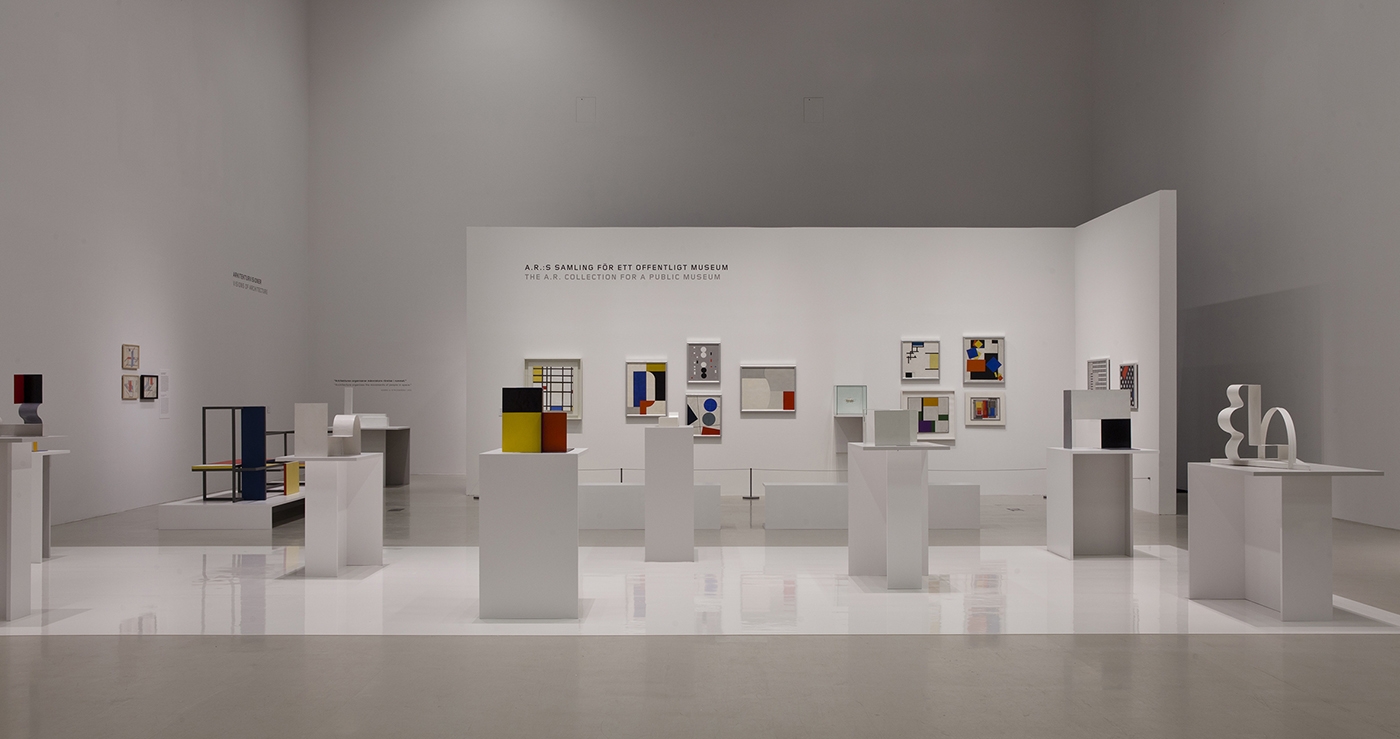
‘Kobro & Strzemiński: New Art in Turbulent Times’, exhibition view, photo: Helene Toresdotter, Moderna Museet
For painting, these intrinsic laws include: flatness (stemming from the flatness of a canvas), geometricism (stemming from the geometric shape of a canvas), “localization of the painterly action within a picture” and avoidance of any illusion of movement (since the painting is a static object by nature).[3] This necessarily has to result in rejection of any narrative and of all references to what exists beyond the painting (the real world, literary content, the artist’s internal life), as well as to elimination of any contrasts (as a potential source of dynamism that disrupt the flatness and static nature of the picture). A work of art becomes a “real being” only “when it constitutes an end for itself and does not seek justification in values that exist beyond the picture.”[4] Elsewhere Strzemiński states: “A work of art does not express anything. A work of art is not a sign of anything.”[5] Everything that transcends the logic of the painting itself creates a work that is non-indentical with itself and thus must be rejected. Introducing any foreign elements brings conflict between the “inherent qualities of the painting… and what is ultimately painted on its surface” and results, as the artist says, in “the violation of its organicity.”[6]
The organicity was to find its fulfilment in the conception of unist painting, which was codified by Strzemiński in the second half of the 1920s. All divisions underwent gradual nullification; all contrasts and other elements that could give an impression of movement or three-dimensionality were eliminated. In the final paintings of the unist series, the surface is uniformly covered with a single colour, but – to avoid the unwanted impression of depth – the paint was applied in the form of a relief pattern. Instead of central composition – which could evoke centrifugal dynamism – unist paintings implement a rule of full equivalence. As Strzemiński declares: “Every square centimetre of the picture is of equal value and plays its part in the picture’s construction in the same degree.”[7]
The same idea of the unity and organicity of the work of art, the idea of its agreement with its own innate properties, was simultaneously developed by Katarzyna Kobro in sculpture. Yet this time, the idea, which in painting led to separation of the work of art from the world, in sculpture united them. This was because, to quote Kobro and Strzemiński: “The main condition for the existence of sculpture should be its complete unity with space. Sculpture should not be opposed to space and isolated from it but should unite with space and continue it.”[8] Just as the rectangle of canvas and its flatness constitute the inherent nature of the painting, the inherent nature of sculpture is consisted of the infinity of space and the connectivity of the sculpture with it. Contrary to hitherto held beliefs, what determines the specific character of the sculpture is not the solid mass but the fact that sculpture is intrinsically a form of organizing and condensing space. The solid mass separates itself from space, divides space into an internal and external sphere, and consequently disrupts the innate continuity and inseparability of space. In Kobro’s interpretation, the history of sculpture is the history of an ever-deeper integration of sculpture with space. That is completed in unist sculpture, wherein the total fusion of internal and external space is achieved through the subordination of composition to rhythm. She defines rhythm as a mathematically regulated sequence of spatiotemporal appearances. It is composed of both spatial forms and planes of colour. Because the rhythm is based on one mathematical algorithm, it can be developed beyond the limits of the sculpture, endlessly. As she says: “open rhythm, which begins within sculpture, moves out into space, connecting sculpture with space.”[9]
As mentioned, the idea of organic unity was deduced from the very nature of painterly and sculptural artwork and seems to be applicable only in the field of art production. Kobro and Strzemiński, however, saw their own experimentation in this field as politically motivated and resulting in political consequences.
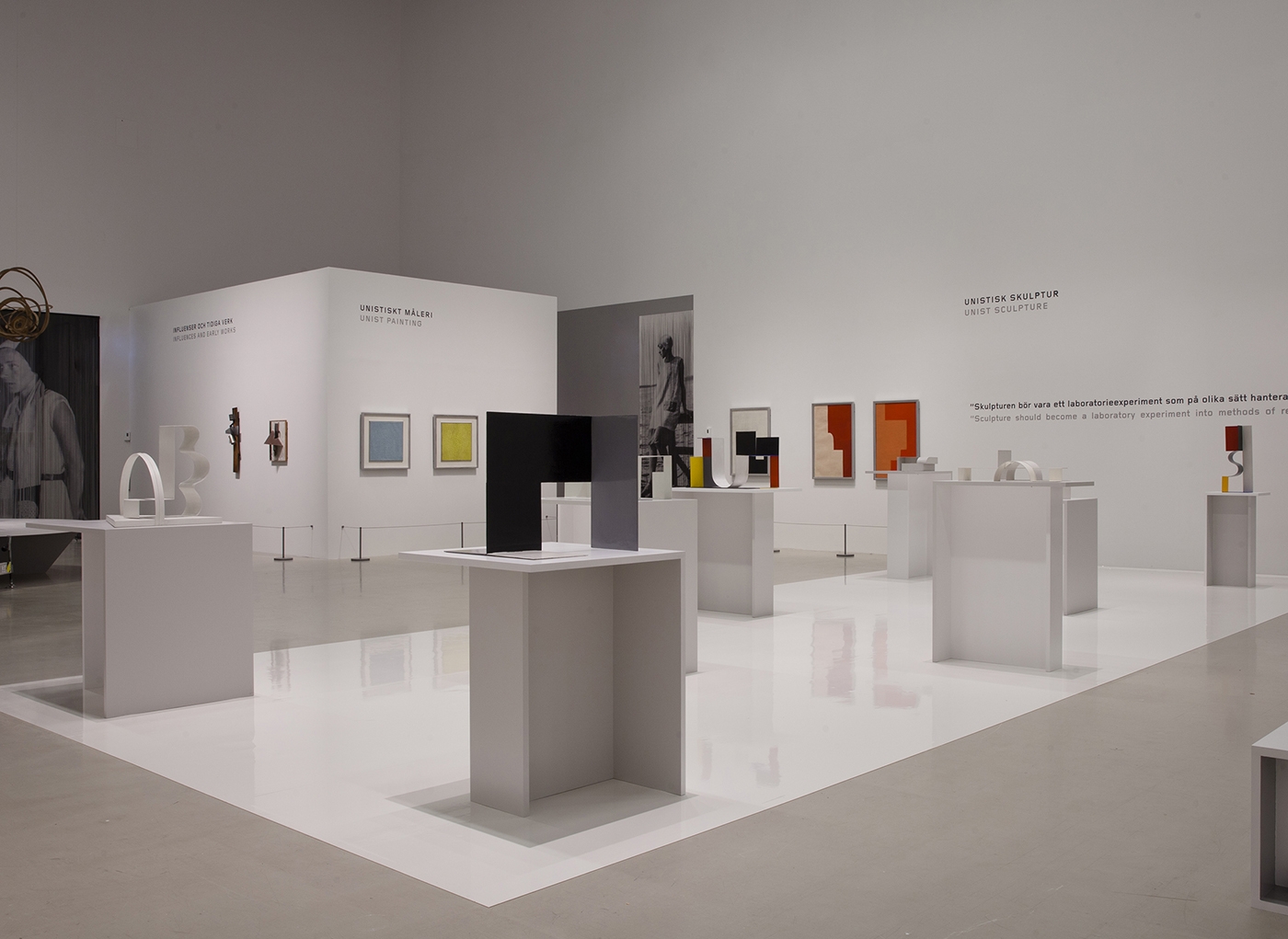
‘Kobro & Strzemiński: New Art in Turbulent Times’, exhibition view, photo: Helene Toresdotter, Moderna Museet
Kobro and Strzemiński came from the circle of the radical Russian avant-garde, where the belief that art should participate in the process of transforming society was widely shared. In this context, a concept of art as a laboratory practice was elaborated. Its interpretations differed significantly, yet what joined them together was the assumption that artists, by means specific to their profession, should conduct explorations and research, the effects of which could be used to improve the conditions of social life. Tatlin and Rodchenko, artists associated with so-called “laboratory constructivism,” postulated investigation of the constructional and textural properties for the needs of industry. In turn, the laboratory art of Kandinsky and Malevich was to support the formulation of new “visions of life” through analyses of the elementary energies that drive the universe and could be employed to transform social reality.
Kobro and Strzemiński rejected an idea that artistic activity should be reduced to supporting industrial production, while at the same time they maintained a distance from the metaphysical idealism of Malevich. According to them, art should be a process of constant prototyping of consistent organizational solutions in the domain of pure forms. And conversion of them into practical, socially useful devices should be a role of architects, urban planners, engineers, technicians, and – politicians. The concept of the organic unity – as well as its painting and sculptural renderings – were to inspire all these professionals to design everyday objects, houses, cities, and, finally, social structures in the likeness of, as Kobro used to say, “functional organisms.”[10]
In a sense, the unist work can be, then, seen as a material model for a new, organic society. Or, in other words, a better society would be the ultimate unist work of art. As Strzemiński states in his letter to Leon Chwistek, another important figure of the Polish avant-garde: “The search for unity is the deepest and most universal driving force of our times. It provides a social foundation of unism. Changes in state organization favour the creation of supraindividual arrangements of interrelated elements.”[11] Unism, therefore, would be the answer to the crisis within the bourgeois forms of societal organization. Such forms that are not organic because they are based, firstly, on hierarchies generating contrasts that disrupt unity, secondly, on individualism that results in a lack of connection among parts of the whole, and thirdly, on an arbitrariness that denies the innate rationale of the social body.
Kobro and Strzemiński’s theory echoes certain hypotheses developed by organicism, a philosophical tendency that was popular in the interwar period. In particular, the version of organicism authored by Pyotr Kropotkin, a scientist, philosopher, and anarchist thinker, very influential in the circles of the Russian avant-garde, should be recalled here. According to him, nature, the social world, and the realm of human production altogether create the universe governed by a single set of laws derived from biology. In this view, societies are collective living entities, their components resemble organs, and social processes are parallel to organic processes. Kropotkin believed that society, like any organism, can develop properly only when its individual parts are in harmonious relationships with each other. On this basis, he drafted a radical vision of a future, state-free community founded on altruism, non-violence, and cooperation. This vision differed fundamentally from another organicist view of the same period, that of Nazism, in which the fantasy of the nation as one body resulted in extermination of those who were considered a threat to its integrity, health, and racial purity. It seems that Strzemiński had exactly this in his mind, when, in 1934, he wrote about a state policy emerging at that time, which under the rhetoric of unity hid completely antidemocratic and terrifying intentions…
The rise of Nazism, or of fascism in general, as well as the Great Depression that had devastating effects on the world economy and social life in many countries, including Poland, prompted Strzemiński and Kobro to reformulate their artistic strategies in regard to the social goals they wanted to achieve. Unism was rooted in the revolutionary optimism that was sustained over the course of the 1920s by rapid economic, industrial, and technological developments, and aided belief in the power of the human mind and the possibility of a transformation of the world driven by reason. As Strzemiński comments, the 1920s were a period during which Fordist rationalization “drastically decreased production costs and created serial, democratic methods of satisfying the needs of the entire human race.”[12] The evolution of mass culture and its primary medium – the cinema – “allowed entire crowds of people to peek through the window of the screen and gaze at remote corners of the world, producing an illusion of the unity of humankind. . . Armed with modern technology, man undertook tasks that surpass the wildest dream of utopians of the past. . . It seemed that the rapid development of production capabilities, in tandem with favourable economic conditions, could create the most perfect social systems and liberate humanity from the chains of history.”[13]
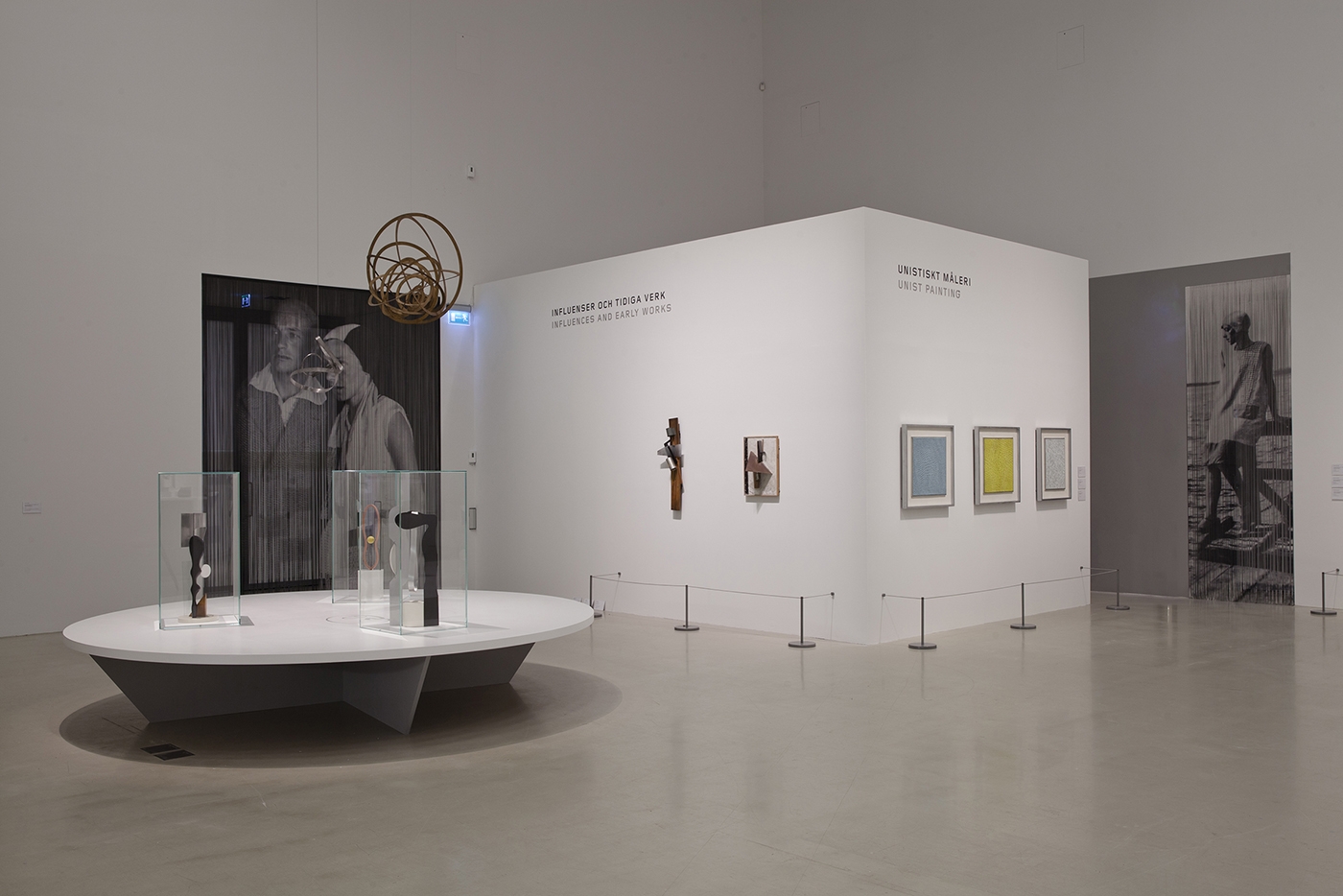
‘Kobro & Strzemiński: New Art in Turbulent Times’, exhibition view, photo: Helene Toresdotter, Moderna Museet
The Great Depression fractured that vision, revealing the dark, irrational side of economic development. The capitalist economy turned out to be the result of “games of blind forces” that in the 1930s brought the worst dregs to the surface, “heralding the coming of an era in which the basest of social instincts would reign supreme.”[14]
According to Polish artists, those dark forces must be opposed by the ideals of collectivity, rational organization, construction, harmony, and purposefulness. The artists intended to achieve their aim by “drafting utilitarian and organizational norms and methods of artistic practice or through actual collaboration between artist, social worker, and technician on the direct shaping of forms of living.”[15] They didn’t give up making purely artistic works, but it was the question of the direct utility of their artistic explorations that became crucial for them. After all, as Strzemiński declared, an artistic idea “is actualized not through painting but through utilitarian planning of the course of everyday life.” And the fundamental change could be achieved “only through mass implementation, rather than producing singular pictures.”[16] Kobro added: “Sculpture should become an architectural issue, a laboratory-like effort to organize methods of planning space, movement, and city landscapes to resemble a functional organism, stemming from the production capabilities of modern art, science, and technology.”[17] In this way, unism was transformed into functionalism, and the interest of the artists shifted onto architecture, urban planning, industrial design, and graphic design. These were the tools by which the social structure and the existence of the individuals were to be rationalised, organised, and thus improved.
Architecture as an organizer of human life appeared in Strzemiński’s writings as early as the second half of the 1920s. In one piece he states that the architect’s task is to design buildings in accordance with the usual way of life of a man and the economy of his efforts. In this way, the interior layout of a building becomes a sort of orchestrator of human movements, arranging them the most conveniently and smoothly. As he writes, “The final end of architecture is . . . to be a regulator of the rhythm of social and individual life.”[18] Therefore, architecture cannot focus on designing a single interior or an individual building; designing should cover the whole space in which a human functions. Yet, while in his texts from the 1920s architectural design is seen as a response to natural human activities, in the 1930s it becomes an active creator of them. Forming the entirety of life, architecture contributes to the transformation of society in line with the logic of its historical development.
Strzemiński created his first architectural work in 1923. It was a design for a New Railway Station in Gdynia. Gdynia, a port city built from scratch, was regarded the flagship of the modernisation of Poland at that time. Thus, in designing this building, Strzemiński confirmed that his ambition was not simply to create works of art but to participate in projects that aimed to change the whole social reality.
Strzemiński’s most important implementation of these architectural principles was his postwar Neoplastic Room, created in 1948 for the Muzeum Sztuki in Łódź as a space for the collection of European avant-garde art. The walls, the floor, and the ceiling of the room were divided into rectangular and square planes filled with primary colours and non-colours. Against such a background, Strzemiński placed Kobro’s sculptures and paintings hailing from the avant-garde collection. The room also contained furniture items and exhibition devices designed by Strzemiński, clearly referencing De Stijl aesthetics but much more austere in expression and sparse in terms of colours. All these elements were to organize the movements and gazes of the museum’s visitors and in this way shape their experience.
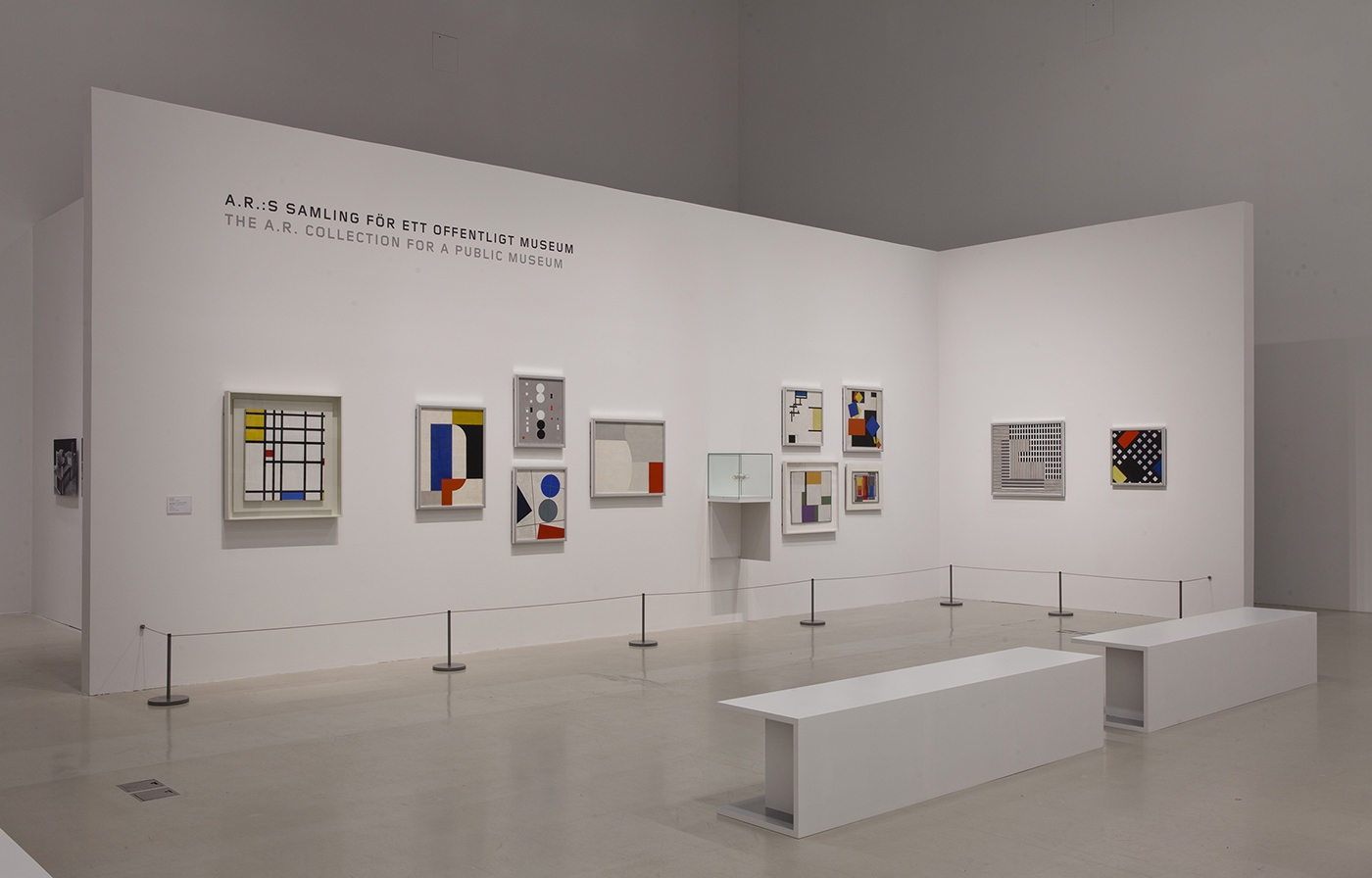
‘Kobro & Strzemiński: New Art in Turbulent Times’, exhibition view, photo: Helene Toresdotter, Moderna Museet
At the same time, when the Neoplastic Room was built, Strzemiński published an essay called Functionalized Łódź, which had been written already in the 1930s, and presented his conception of urban planning. The whole conception was based on the principle of equivalence known from his unist painting. This meant, in this case, a break with the system of centre-peripheries, and replacing it with a repeatable module of districts planned along the communication route. Each of the districts consisted of the same parts: residential, industrial, commercial-administrative, and educational. And everything was arranged in such a way as to organize human activities in the most economical way.
For both artists the ultimate model of all human activity was labour. They envisioned a well-structured society as a Fordist factory and referred to the principles of the scientific organization of labour, recalling Karol Adamiecki, a Polish author of the original management theory. According to him, perfect organization must be based on the distribution of tasks and the synchronization of individual operations. Adamiecki saw in harmony the basis of good organization, and, like Kropotkin, derived it from the world of nature. At the same time, he emphasized that it is not only the harmonization of bodies, tools, and actions that is important, but also the harmony of emotions. Kobro and Strzemiński shared this opinion, and their projects were intended to regulate both the physical and mental spheres of human life. They aimed at the reorganization of the human psyche, strengthening pro-social, organizational and pro-productive attitudes. “Our psyche, Kobro stated, is in a tangle, being over-complicated. Its entanglements are to a large extent due to the condition of the surrounding world – chaotic and disorganized. Being shaped by contradictory forces, society consequently produces a psyche that is uncoordinated and inconsistent.”[19] Only the rational and purpose-oriented organization of life is able to extricate the human being from the yoke of emotional quivering and set him or her on a common course, so that in a joint effort with other humans he/she could change the world for the better, becoming happier in the process – thanks to the feeling of purpose that this effort brings.
In this context, it’s interesting to look at the last unist painting by Strzemiński and the last spatial composition by Kobro. In both of them the biological, amoeba-like forms are juxtaposed with the abstract system that is supposed to produce organic unity. These forms, it should be noted, were associated by Strzemiński and Kobro with surrealism, which they perceived to be an expression of the most primal, primitive, and wild impulses that emerged as a result of emotional turmoil caused by the economic and political crisis. Inscribing them in the unist structure can be, then, interpreted as an attempt to set a rational order into the chaos of the human psyche and subordinate it to the objectives of the social whole.
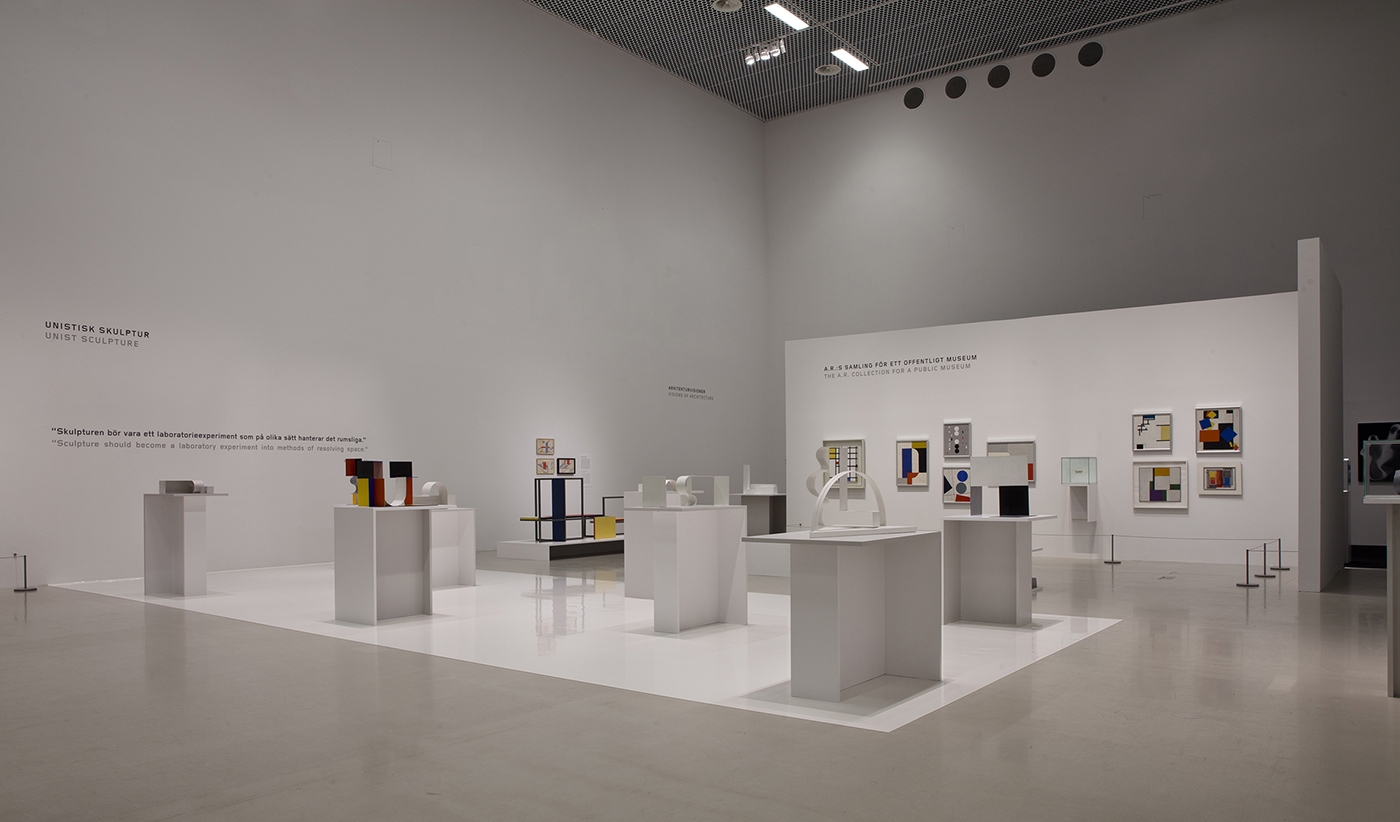
‘Kobro & Strzemiński: New Art in Turbulent Times’, exhibition view, photo: Helene Toresdotter, Moderna Museet
In conclusion, we can say that Kobro and Strzemiński’s biopolitics revolve around the issue of the rational management of society, and that “rational” means here, on the one hand, providing society with economic efficiency in improving living conditions, and on the other, providing the individual life with a sense of meaning, by liberating the individual from the state of “biological” existence and socialization through work. To achieve these goals, the artists created painting and sculptural prototypes of the organizational structures conceived as an inspiration for those who arrange social life. Secondly, they designed prototypes of the concrete architectural and urban solutions to orchestrate actions of the individual body and supra-individual social body to make these actions more rational, economical, and purposeful. And finally, they employed painting, sculpture, industrial design, and architecture to create an environment which, by means of forms, textures, and colours, would stimulate emotions and attitudes of individuals, encouraging them to pro-social and productivist behaviours.
The biopolitics of Kobro and Strzemiński is, then, radically egalitarian, but at the same time totalizing and uniformizing. It assumes reducing the complexity of individual beings, bringing them to a common denominator, and expresses a lack – shared with other protagonists of the modern avant-garde – of understanding for differences and idiosyncrasies. Therefore, it hardly meets the standards of today’s democratic politics. If the legacy of these artists has remained inspiring for the following generations, it was not then because of the model of political society they proposed, but because of the way they saw the political role of art and the political responsibilities of the artist. This vision was based on their disagreement with the instrumentalisation of art through politics and a conviction that it is rather politics that should be shaped by art. What is also important, Kobro and Strzemiński were fully aware that the political solutions proposed by art are historically determined, therefore what is appropriate in a given moment does not have to be such in another. It means, then, that their totalist and unifying concept of unism should be understood as a response to the particular political and social conditions of the times in which it had been invented.
That is why Kobro and Strzemiński could become a point of reference for those artists who resisted the totalitarian politics of Stalinism in the 1950s, and the conformist uniformization of the so called real socialism of the 1960s and 1970s. Their uncompromising attitude, the struggle to defend the autonomy of art, and at the same time their deep social commitment created a model for those who rejected the ostensible involvement of official propaganda art but also did not want to lose the social depth of their own artistic practice.
Today, in new political circumstances, when the world is suffering primarily from the syndrome of TINA – There Is No Alternative – what seems the most relevant in Kobro and Strzemiński’s stance is their courage in going beyond the horizon of what is possible at a given time and their willingness to invent new social dispositifs that would change life for the better. At the end of the day it was not a concrete solution they developed that counts but the fact that their art puts our social imagination in motion.
This text first appeared in the catalogue for the exhibition Kobro & Strzemiński: New Art in Turbulent Times, Moderna Museet Malmö, 10 March – 2 September 2018
[1] See: Władysław Strzemiński, „I define art…” in Constructivism in Poland 1923–1936: Blok, Praesens, a.r., ed. Ryszard Stanisławski, Essen: Museum Folkwang; Otterlo, the Netherlands: Rijksmuseum Kröller-Müller, 1973, 68; originally published as “Określam sztukę . . .,” in Katalog Wystawy Nowej Sztuki, Vilnius: Lux, 1923.
[2] Michael Foucault, „The History of Sexuality” Vol. I “An Introduction”, New Yoork: Pantheon Books, 1978, 143.
[3] Władysław Strzemiński, “I define art. . .”, 68.
[4] Władysław Strzemiński, “B = 2,” in Art between Worlds: A Sourcebook of Central European Avant-Gardes, 1910–1930, ed. Timothy O. Benson and Éva Forgács, Cambridge, MA: MIT Press, 2002, 497–503; originally published as “B = 2,” Blok 8–9 (1924).
[5] Władysław Strzemiński, “To, co się prawnie . . .,” Blok 2 (1924), 2.
[6] Władysław Strzemiński, “Notatki,” Zwrotnica 11 (1927), 243.
[7] Władysław Strzemiński, “Unism in Painting,” in Art between Worlds…, 654; originally published as Unizm w malarstwie, Warszawa: Biblioteka “Praesens”, 1928.
[8] Katarzyna Kobro and Władysław Strzemiński, “Composing Space: Calculating Space-Time Rhythms,” October 156 (2016), 28–29; originally published as Kompozycja przestrzeni: Obliczenia rytmu czasoprzestrzennego, Łódź: Biblioteka “a.r.”, 1931.
[9] Ibid., 37.
[10] Katarzyna Kobro, „For people unable to think…”, in Katarzyna Kobro 1898 – 1951, exh. cat. (Leeds: Henry Moore Institute; Łódź: Muzeum Sztuki, 1999), 153; originally published as “Dla ludzi niezdolnych…,” Forma 3 (1935).
[11] “Dyskusja L. Chwistek—W. Strzemiński,” Forma 3 (1935): 4.
[12] Władysław Strzemiński, “Aspekty rzeczywistości,” Forma 5 (1936), 12.
[13] Ibid.
[14] Ibid.
[15] Ibid., 11.
[16] Ibid.
[17] Katarzyna Kobro, „For people unable to think…”, 153.
[18] Władysław Strzemiński, „The Principles of New Architecture”, in Constructivism in Poland…, 109; originally published as “Zasady nowej architektury”, Linia 3(1931).
[19] Katarzyna Kobro, “Functionalism,” in Katarzyna Kobro 1898–1951…, 155; originally published as „Funkcjonalizm”, Forma 4 (1936).
Imprint
| Artist | Katarzyna Kobro, Władysław Strzemiński |
| Exhibition | Kobro & Strzemiński: New Art in Turbulent Times |
| Place / venue | Moderna Museet Malmö |
| Dates | 10 March – 2 September 2018 |
| Curated by | Iris Müller-Westermann, Ory Dessau, and Jaroslaw Suchan |
| Photos | Helene Toresdotter/Moderna Museet |
| Website | www.modernamuseet.se/malmo/en/ |
| Index | Jarosław Suchan Katarzyna Kobro Moderna Museet Moderna Museet Malmö Władysław Strzemiński |
